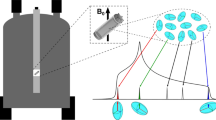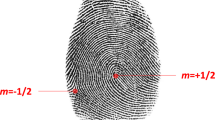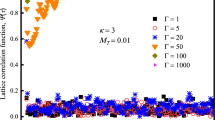Abstract
The free volume micro-structural properties of propylene glycol obtained by means of molecular dynamics simulations have been investigated and compared with the experimental data from positron annihilation lifetime spectroscopy (PALS). The results are also compared to those recently obtained on glycerol. The bulk microstructures of the samples have been analyzed in the temperature range 100–350 K with a probe-based procedure for exploring the free volume cavities of the microstructures. The basic free volume property, i.e., mean cavity volume, is compared with the hole volume data from PALS. A comparison between calculated and experimental data suggests the existence of a threshold volume for the smallest cavity detectable by PALS, which may be ascribed to fast local motions of the matrix constituents. At high temperatures the cavity analysis reveals the formation of an infinite cavity, i.e., percolation phenomenon. The onset temperatures of the percolation process in propylene glycol and glycerol are found to be close to the characteristic PALS temperature \(T^{\rm L}_{\rm b2}\) , where a pronounced change in the PALS response occurs, as well as to the characteristic dynamic Schönhals temperature \(T^{\rm SCH}_{\rm B}\) , and Stickel’s temperature \(T^{\rm ST}_{\rm B}\) , marking a dramatic change in the primary α properties.
Similar content being viewed by others
References
Donth E (2000). The Glass Transition. Springer, Berlin
Adichtchev S, Blochowicz T, Tschirwitz C, Novikov VN, Rössler EA (2003). Phys Rev E 68: 011504
Stickel F, Fischer EW, Richert R (1996). J Chem. Phys 102: 6251
Stickel F (1995) PhD Thesis, Shaker Verlag Aachen
Schönhals A (2001). Europhys Lett 56: 815
Goldstein M (1969). J Chem Phys 51: 3728
Paluch M, Casalini R, Roland M (2003). Phys Rev. E 67: 021508
Casalini R, Ngai KL, Roland CM (2003). Phys Rev B 68: 014201
Bartoš J, Šauša O, Krištiak J, Blochowicz T, Rössler E (2001). J Phys Cond Matt 13: 11473
Ngai KL, Bao LR, Yee AF, Soles ChL Yee (2001). Phys Rev Lett 87: 215901
Bartoš J, Šauša O, Bandžuch P, Zrubcová J, Krištiak J, Non-Cryst J (2002). Solids 307–310: 417
Bendler JT, Fontanella JJ, Shlesinger MF, Bartoš J, Šauša O, Krištiak J (2005). Phys Rev E 71: 0315089
Račko D, Chelli R, Cardini G, Bartoš J, Califano S (2005). Eur Phys J D 32: 289
Procacci P, Darden TA, Paci E, Marchi M (1997). J Comput Chem 18: 1848
CornellWD, Cieplak P, BaylyCI, Gould IR, Merz KM, Jr., Ferguson DM, Spellmeyer DC, Fox T, Caldwell JW, Kollman PA (1995) J Am Chem Soc 117:5179
Chelli R, Procacci P, Cardini G, Della Valle RG, Califano S (1999) Phys Chem Chem Phys 1:871 (The σ parameters of the Lennard-Jones potential reported in Table 1 are wrong. The correct values are: 3.4, 3.0665 and 2.4713 Å for the atoms C, O and non-hydroxy H, respectively)
Andersen HC (1980). J Chem Phys 72: 2384
Hoover WG (1985) Phys Rev A 31:1695; Hoover WG (1986) Phys Rev A 34:2499
Kovacs AJ (1964). Fortschr Hochpolym-Forsch 3: 394
Parks GS, Huffman HM (1927). J Chem Phys 31: 184
Beiner M, Huth H, Schröter K (2001). J Noncryst Sol 279: 126
Sastry S, Truskett TM, Debenedetti G, Torquato S, Stillinger FH (1998). Mol Phys 95: 289
Tao SJ (1972). J Chem Phys 56: 5499
Eldrup M, Lightbody D, Sherwood JN (1981). Chem Phys 63: 51
Nakanishi H, Wang SJ, Jean YC (1988) In: Sharma SC (ed) Positron annihilation studies of fluids. World Scientific, Singapore p 292
Bartoš J, Šauša O, Krištiak J (in press)
Bartoš J, Šauša O, Račko D, Krištiak J, Fontanella JJ (2005). J Noncryst Solids 351: 2599
Bartoš J, Račko D, Šauša O, Krištiak J (2007) Positron annihilation lifetime spectroscopy and atomistic modeling—effective tools for the disordered condensed system characterization, ARW NATO Series. Springer, Berlin, p 110
Author information
Authors and Affiliations
Corresponding author
Electronic Supplementary Material
Below is the Electronic Supplementary material.
Rights and permissions
About this article
Cite this article
Račko, D., Chelli, R., Cardini, G. et al. Free volume from molecular dynamics simulations and its relationships to the positron annihilation lifetime spectroscopy. Theor Chem Account 118, 443–448 (2007). https://doi.org/10.1007/s00214-007-0283-9
Received:
Accepted:
Published:
Issue Date:
DOI: https://doi.org/10.1007/s00214-007-0283-9




